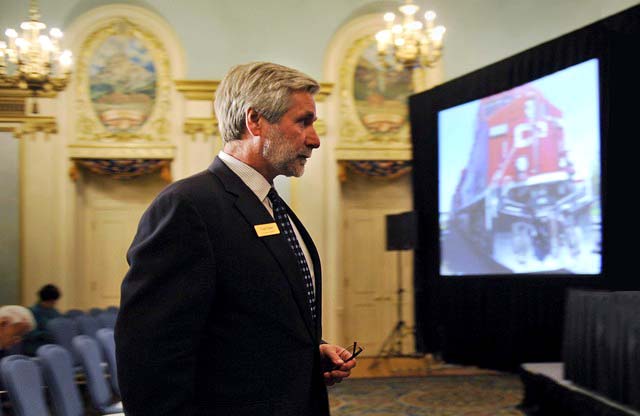
2011
|


Fred Green, president and CEO of Canadian Pacific Railway, arrives at the company's annual general meeting in Calgary,
Alberta, 12 May 2011.
7 November 2011
Gradient Steepens for Canadian Pacific
Calgary Alberta - Fred Green is a marked man. The 54-year-old chief executive of Canadian Pacific Railway has emerged as the prime
target of unhappy investors, led by Pershing Square Capital Management, the activist hedge fund that has built up a 12.2 percent stake in the Calgary-based
rail operator.
Mr. Green, who has worked for CP Rail for 31 years and took over as chief executive in 2006, is blamed for tolerating a culture that critics cite as the key
reason why CP Rail's performance lags behind the US and Canada's six other Class I railroads.
"There has been a level of dissatisfaction among the investor base with CP's execution over the past nine or 10 years," said Fadi Chamoun, analyst at
BMO Capital Markets.
The 130-year-old railway's culture, the critics say, is a hangover from the 1980s and 90s when it was part of the sprawling Canadian Pacific conglomerate,
which also held interests in hotels, mining, shipping, and oil and gas. CP was broken up in 2001.
Unhappiness with Mr. Green's performance has bubbled up since Pershing disclosed its stake last week. According to one critical posting on The Globe and Mail's
website: "If there's one company that is top-heavy, this is it. CP restructures twice a year... it spends millions making cuts everywhere but where
they are needed, in management".
Another read: "Let's clean up shop and hire people that will bring the umphh into our everyday working lives."
Pershing has wasted little time making its views known to CP Rail's board. The railway declined to comment on any meetings, saying: "This is a
private shareholder matter."
At a time when railroads are generally performing well, CP Rail's performance is often compared to its Montreal-based rival Canadian National, which has been
transformed over the past 15 years from a sleepy government organisation into the most efficient of the Tier I railroads.
CN's operating ratio, or operating costs as a proportion of sales, improved to 59.3 percent in the third quarter from 60.7 percent a year earlier. By contrast,
CP Rail's ratio, tucked away in its financial statements, deteriorated from 73.7 percent to 75.8 percent.
CP Rail does have some inbuilt disadvantages. Two-thirds of its volumes come from its western operations, where it faces steeper gradients, and thus higher
fuel and maintenance costs, and more severe winter weather than rivals.
Its pricing power is limited by its heavy dependence on a handful of commodities, notably grain, coal, and potash. Teck, a big coal exporter, and Canpotex, a
potash-marketing cartel, make up about a fifth of its business.
Nonetheless, Pershing and other critics have grown weary of hearing Mr. Green blame such factors for the company's mediocre performance.
One investor poured scorn on its plans to hire more crews and bring more locomotives into service this winter to avoid a repetition of last year's disruptions,
saying that such moves do nothing to improve productivity.
Mr. Chamoun said: "I don't think they can achieve CN's margins, but they can achieve better than they do now."
Mr. Green told analysts last month: "I'm satisfied with our progress," adding: "The railroad... is on a path of steady
improvement." It aims to lower its operating ratio to close to 70 percent.
Even so, his ambitions appear to have limits. "Always remember that whatever we do has to be compared to the competition," he said. "So if their
game is elevating and ours is elevating, that's good for the customer, good for the fluidity of the railway and the industry. But it may not provide a
competitive advantage."

|
